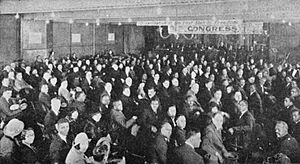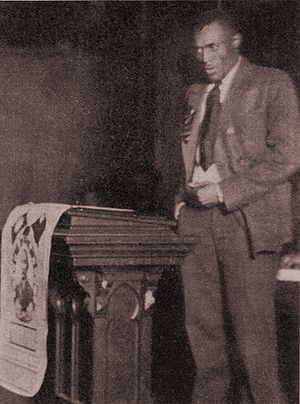American Negro Labor Congress facts for kids
The American Negro Labor Congress (ANLC) was an organization started in 1925 by the Communist Party. Its main goals were to fight for the rights of Black Americans, share ideas about communism within the Black community, and encourage Black Americans to join the Communist Party.
The ANLC strongly opposed segregation (keeping people of different races separate) in many labor unions, especially those linked to the American Federation of Labor. They also campaigned against lynching (when a mob kills someone, often by hanging, without a legal trial), laws that stopped Black Americans from voting, and Jim Crow laws (state and local laws that enforced racial segregation in the Southern United States). In 1930, the group changed its name to the League of Struggle for Negro Rights.
How It Started
Early Ideas
Before the ANLC, the Communist Party had another group focused on Black American issues called the African Blood Brotherhood (ABB). This group was small and eventually faded away by 1924.
The Communist International (Comintern), a global organization that supported communist parties, wanted the American Communist Party to create a new, larger group to help Black workers. This led to the idea for the American Negro Labor Congress.
A key person behind this idea was Lovett Fort-Whiteman. He was an organizer for the ABB and had traveled to Moscow for training. In 1924, he wrote to the head of the Comintern, suggesting a meeting called an "American Negro Labor Congress." This idea was supported, and plans began for a convention in Chicago.
Calling the Convention
The official invitation for the American Negro Labor Congress meeting was sent out in the spring of 1925 by the Communist Party. Although it was first planned for the summer, the founding convention actually took place in Chicago on October 25, 1925.
The Communists wanted the ANLC to seem like a broad organization, not just a Communist one. This was a tactic to attract more members and challenge groups like the NAACP and Marcus Garvey's UNIA. The invitation said that delegates should represent Black or mixed-race unions, farm workers, or factory workers.
Lovett Fort-Whiteman became the national organizer for the new group. He had studied party organization in Moscow and was seen as a top Black leader in the party. Fort-Whiteman believed that focusing on fighting racism was the best way to connect with Black Americans.
The call for the convention focused on many important issues. These included ending Jim Crow laws, stopping restrictions on Black voting, ensuring equal access to public places like theaters and restaurants, ending discrimination in education, and making lynching a federal crime.
The First Meeting
The first convention of the American Negro Labor Congress began on October 25, 1925. Lovett Fort-Whiteman gave a main speech, saying the group was formed to bring together "enlightened and militant" Black workers to achieve specific goals.
About 40 delegates attended this first meeting. A key idea was that "Organization is the first step to freedom." Another important point was the need for Black workers to join trade unions. If existing unions wouldn't allow Black members, then Black workers should create their own unions.
The convention passed resolutions demanding "full equality of the Negro people" everywhere. They called for an end to Jim Crow laws, segregation, voting discrimination, and discrimination in education, housing, and public places. The group also spoke out against the Ku Klux Klan and the unfair practice of not allowing Black jurors in trials involving Black defendants. They also criticized segregation in the U.S. military.
The Comintern also helped the ANLC financially, providing money for organizers' salaries, travel, and materials like pamphlets.
Activities and End
The American Negro Labor Congress had its own newspaper called The Negro Champion, which was published in New York. Later, in 1929, this was replaced by a magazine called The Liberator.
In 1930, the Communist Party decided to end the American Negro Labor Congress. It was replaced by a new organization called the League of Struggle for Negro Rights.




